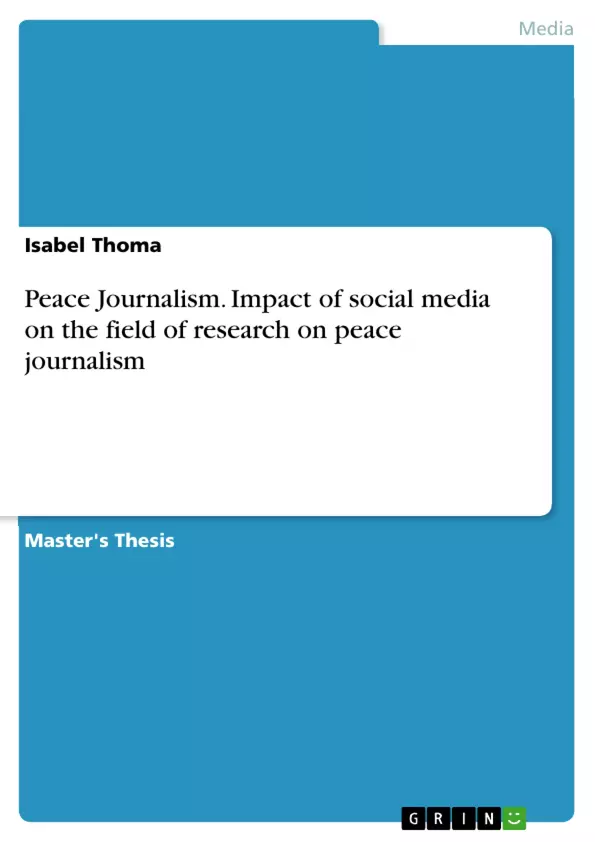The results of the present work seek to clarify the question in what ways does the phenomenon of social media change how we have defined, explored, and implemented peace journalism thus far? For only when it is apparent how seriously this new reality affects the concept of peace journalism and its practical implementation will the need for further research also become clear.
Peace journalism plays a role and has the potential to sensibilize people to conflicts, to have a de-escalating effect and thus ultimately to promote peace. The ideas behind the concept of peace journalism gained importance primarily through the articles of Johann Galtung in the 1960s. Initially formulated as a theory, the ideas found increased application in practice in the 1990s, were implemented by journalists and is nowadays a firmly established, if not uncontroversial, subfield in journalism.
Despite its potential, peace journalism is not a miracle cure. The concept has its limits of effectiveness and applicability and misapplied, may do more harm than good. Peace journalism has an impact on the readership and is no less popular than so-called war journalism, but it reaches people especially if they are not hardliners who have already established a war frame of the situation. Peace journalism will therefor never be able to transform an entire society but can make a start with certain people at certain times, from where the idea can spread and possibly become established and have long-term effects.
However, it is noticeable that the idea of peace journalism as currently formulated is becoming increasingly irrelevant in practice due to the changing media landscape, namely the technologies of social media. Research that aims to advance peace journalism must therefore first and foremost examine social media, their modes of action, their functions, their respective audiences, their potential and their dangers.
Inhaltsverzeichnis (Table of Contents)
- Abstract
- Introduction
- Theoretical Framework
- Social Media: Emergence and Definition
- Peace Journalism: Origin and Development
- Definition
- State of Research
- Criticism and its Counterarguments
- Method: Applied Systematic Literature Review
- Results and Analysis of the Literature
- Comparative Analysis of the Formal Criteria
- Comparative Analysis of the Content Aspects
- Discussion
- Content-related Aspects
- Research Gap or Limitations of the present Study?
- Impeding Effects of Social Media on Conflict Reporting
- Beneficial Impacts of Social Media on Conflict Reporting
- Influence of Social Media on PJ
- Significance of the Results for Future Research
- Content-related Aspects
- Conclusion
- Reference List
Zielsetzung und Themenschwerpunkte (Objectives and Key Themes)
This paper explores the impact of social media on peace journalism (PJ) research. It aims to examine how the changing media landscape influences the definition, exploration, and practical implementation of PJ. By utilizing a systematic literature review, the paper identifies key research gaps and highlights the urgent need for further investigation to maintain the relevance and effectiveness of PJ in the digital age.
- The evolving role of social media in conflict reporting and its impact on PJ.
- Research gaps and limitations concerning the intersection of PJ and social media.
- The potential for social media to both hinder and benefit conflict reporting, particularly for PJ.
- The need for further research to adapt and optimize PJ in light of social media's influence.
- The significance of PJ in promoting peacebuilding and conflict resolution amidst a changing media landscape.
Zusammenfassung der Kapitel (Chapter Summaries)
- Introduction: This chapter provides an overview of the peace-promoting and conflict-related journalism concepts, with a focus on peace journalism (PJ). It highlights the development of PJ in the 1990s and 2000s, coinciding with the emergence of the internet and social media. The chapter argues that PJ research has not adequately addressed the impact of social media on its field.
- Theoretical Framework: This chapter delves into the definitions and development of both social media and peace journalism. It discusses the origins, definitions, state of research, and criticisms surrounding PJ, providing a foundational understanding of the concept.
- Method: Applied Systematic Literature Review: This chapter details the methodology employed in the research, outlining the systematic literature review process used to examine relevant articles on the intersection of PJ and social media.
- Results and Analysis of the Literature: This chapter presents the results of the literature review, analyzing both formal criteria and content aspects of the selected articles. The chapter highlights findings related to the positive and negative influences of social media on conflict reporting, particularly in the context of PJ.
- Discussion: This chapter engages in a discussion of the research findings, addressing key themes such as research gaps, the impeding and beneficial impacts of social media on conflict reporting, and the influence of social media on PJ. It emphasizes the need for future research to adapt and optimize PJ in light of social media's impact.
Schlüsselwörter (Keywords)
This work focuses on the intersection of peace journalism (PJ) and social media, exploring the influence of this new media landscape on the field of conflict reporting. Key themes include the impact of social media on PJ's definition, implementation, and research, highlighting both potential benefits and limitations. The study also emphasizes the urgent need for further research to address the evolving dynamics between PJ and social media, ensuring its relevance and effectiveness in promoting peacebuilding and conflict resolution in the digital age.
- Citar trabajo
- Isabel Thoma (Autor), 2022, Peace Journalism. Impact of social media on the field of research on peace journalism, Múnich, GRIN Verlag, https://www.grin.com/document/1284674



